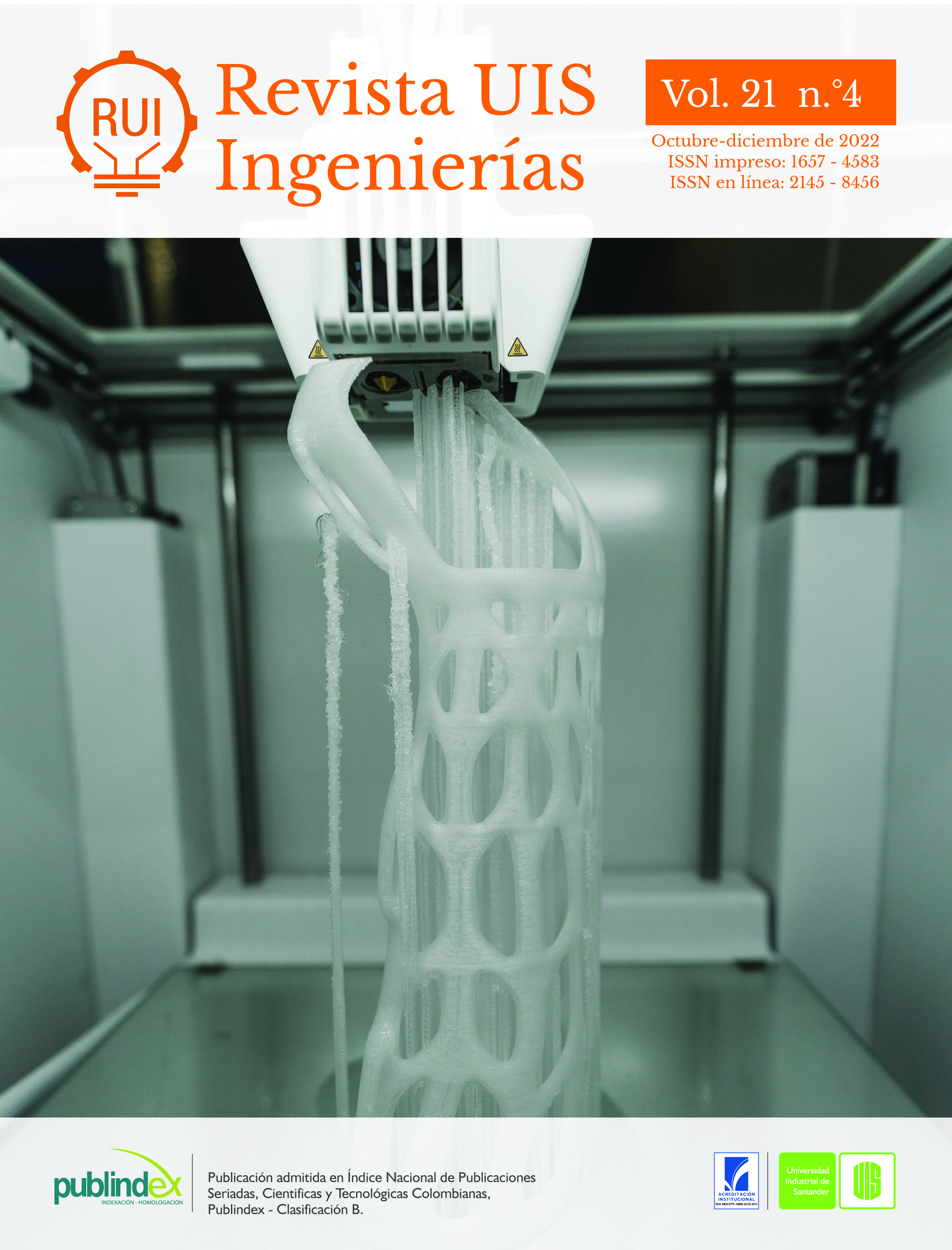Analysis of formability of AISI 304 steel sheets with different thicknesses by the tensile properties
Published 2022-12-09
Keywords
- Anisotropy,
- Formability,
- Metallic sheet,
- Mechanical properties,
- AISI 304L
- Deep drawing,
- Stretched,
- Metalworking industry,
- Microstructure,
- Grain size ...More
How to Cite
Copyright (c) 2022 Revista UIS Ingenierías

This work is licensed under a Creative Commons Attribution-NoDerivatives 4.0 International License.
Abstract
Although AISI 304 steel is widely used and its manufacturers provide resistance data in the quality certificate, these are not sufficient to characterize and predict the behavior of the sheets in the drawing and drawing processes. This is why the objective of this work was to analyze the formability of AISI 304 steel sheets with 16- (thickness 1.5 mm), 18- (1.2 mm), and 20- (0.9 mm) gauges used by the metalworking industry in Colombia by determining intrinsic properties related to the ability of the sheet to withstand stretching and drawing operations such as the strain hardening exponent n, the normal anisotropy rm, and the planar anisotropy Δr. The methodology consisted of analyzing the chemical composition, a metallographic study, and a series of tensile tests. The results show that the steel has a microstructure of twinned austenite grains of size between 15-30 mm. Regarding the mechanical resistance, it was observed that all the mean values of ultimate resistance, elastic limit, and elongation are above the minimum established in the standard. Furthermore, all of the tensile test results changed according to the variation of angles concerning the rolling direction (0°, 45°, and 90°), which indicates the anisotropic character of the sheet. The most relevant result allows us to infer that the 20-gauge sheet has better formability and therefore, better behavior against the stretching and drawing processes.
Downloads
References
- ASM International, Metals handbook volume 14 forming and forging. USA: ASM International, 1996.
- J.E. Barbosa, I.H. García, J. Fuentes, “Estimación vía experimental de la formalidad de láminas de aluminio de pureza comercial”, Rev. Latinoamericana de Metalurgia y Materiales, vol. 29, no. 2, pp. 128-134, 2009. [Online]. Available: http://ve.scielo.org/scielo.php?script=sci_arttext&pid=S0255-69522009000200008&lng=es&tlng=es
- C. L. Casadiego, J. E. Barbosa, I. H. García, “Determinación experimental de la formabilidad de láminas de acero SG295 mediante sus propiedades tensiles,” Rev. colombiana de tecnologías de avanzada, vol. 1, no. 29, pp. 9-15, 2017, doi: https://doi.org/10.24054/16927257.v29.n29.2017.2480
- D.R. Askeland, W.J. Wright, Ciencia e ingeniería de los materiales. México, D. F: Cengage learning, 2017.
- R. Gedney, “Sheet Metal Testing Guide”, ADMET, Inc, vol. 1, no. 1, pp. 1-9, 2013, [Online]. Available: http://admet.com/assets/ADMET-Sheet-Metal-Testing-Guide-July-2013.pdf
- Standard Test Methods for Tension Testing of Metallic Materials, ASTM E8 / E8M, 2013.
- R. Andersson, “Deformation characteristics of stainless steels,” PhD dissertation, Luleå tekniska universitet, Luleå, 2005, [Online]. Available: https://www.diva-portal.org/smash/record.jsf?pid=diva2%3A990918&dswid=-4133
- Standard Test Method for Determining Forming Limit Curves, ASTM E2218, 2015.
- J.A. Newel. Ciencia de materiales, aplicaciones en ingeniería. México, D.F: Alfaomega, 2010.
- J.A. Schey. Introduction to manufacturing processes. United States Of America: McGraw-Hill, 2000.
- S. Kalpakjian y S.R. Schmid. Manufactura, Ingeniería y tecnología. México, D.F: Pearson Educación, 2008.
- Standard Test Method for Plastic Strain Ratio r for Sheet Metal, ASTM E517, 2018.
- A. Güemes, N. Martín, Ciencia de materiales para ingenieros. México, D.F: Pearson Educación, 2013.
- Standard Test Method for Tensile Strain-Hardening Exponents (n -Values) of Metallic Sheet Materials, ASTM E646, 2016.
- N.E Dowling. Mechanical Behavior of Materials. England: Pearson Education Limited, 2013.
- A. E. Tekkaya, T. Altan. Sheet Metal Forming: Fundamentals. USA: ASM International, 2012.
- C. Doerr, J.Y. Kim, P. Singh, J. Wall, L.J. Jacobs, “Evaluation of Sensitization in Stainless Steel 304 and 304L using Nonlinear Rayleigh Waves”, NDT and E International, vol. 88, pp. 17-23, 2017, doi: http://dx.doi.org/10.1016/j.ndteint.2017.02.007
- M. A. Martínez, J. Ordieres, J. Botella, R. Sánchez, R. Parra, “Influencia del tamaño del grano en las propiedades mecánicas de los aceros inoxidables austeníticos”, revmetal, vol. 41, no. Extra, pp. 64–68, 2005, doi: https://doi.org/10.3989/revmetalm.2005.v41.iExtra.1000
- J. Coello, V. Miguel, A. Calatayud, A. Martínez, C. Ferrer, “Deformability analysis of the AISI 304 DDQ stainless steel under deep drawing multiaxial condition. Evaluation of the initial strain influence”, Revista de Metalurgia, vol. 46, no. 5, pp. 435–445, 2010, doi: http://dx.doi.org/10.3989/revmetalm.0967
- M. Toit, H. Steyn, “Comparing the Formability of AISI 304 and AISI 202 Stainless Steels”, Journal of Materials Engineering & Performance, vol. 21, no. 7, pp. 1491–1495, 2012, doi: https://doi.org/10.1007/s11665-011-0044-8
- V. Talyan, R.H. Wagoner, J.K. Lee, “Formability of Stainless Steel”, Metallurgical and Materials Transactions, Vol. 29, no. 3, pp. 2161-2172, 1998. doi: https://doi.org/10.1007/s11661-998-0041-1
- Standard Specification for Chromium and Chromium-Nickel Stainless Steel Plate, Sheet, and Strip for Pressure Vessels and for General Applications, ASTM A240 / A240M, 2020.
- M. J. Serenelli, M. A. Bertinetti, J. W Signorelli, “Influencia de la textura cristalográfica en la dispersión de coeficientes de lankford en una chapa de acero galvanizada de bajo carbono”, Mecánica Computacional, vol XXVII, pp. 993- 1001, 2008. [Online]. Available: https://cimec.org.ar/ojs/index.php/mc/article/view/1467

